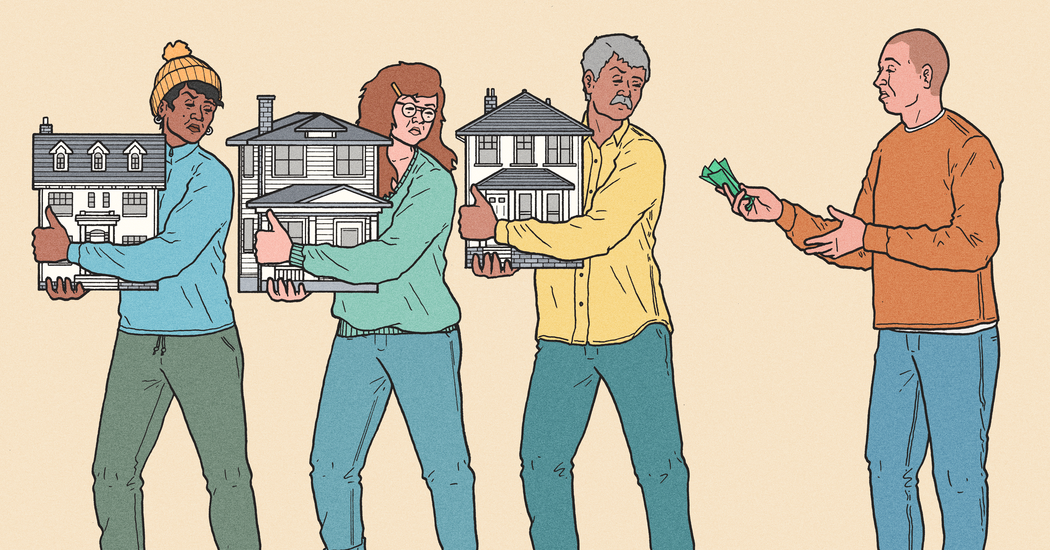The housing market typically comes alive in the spring when buyers turn up in the warmer weather. This year, the market appears to be stuck in a deep freeze, and the main culprit is a lack of sellers, housing experts say.
There is interest among buyers – mortgage applications were 10 percent higher in March than the previous month – but the number of homes for sale is low. Part of the mismatch is caused by homeowners who are tempted to sell but remain on the sidelines, daunted by the high prices and mortgage rates they face as buyers.
More than three-quarters of sellers in a recent survey by Realtor.com said they felt “trapped” in their home by their own low mortgage rates. More than half said they planned to wait for rates to fall before putting their home on the market.
Sandy Robinson, a 71-year-old retired teacher in Fairhaven, Massachusetts, is put off by the market. She’s eager to sell her two-bedroom townhouse, but worries if she can afford a new home. “It’s a little scary right now and you have to be careful,” she said.
A stalemate has thrown the housing market into trouble when it should be more robust. According to the National Association of Realtors, existing home sales were down 22 percent in March from the previous year. The stock of unsold homes on the market at the end of March totaled 2.6 months of stock, meaning it would take them that long to sell. Inventory is typically twice as large to balance supply and demand.
“We’re at a real impasse,” said Robert Frick, a business economist at the Navy Federal Credit Union. “It will be a laborious process to thaw the market and it will take a long time to return to a normal situation of supply and demand.”
Fewer homes for sale means more competition between buyers, leading to bidding wars and price increases. While lower than recent highs, the average home price remains about 40 percent higher than it was at the start of 2020, according to the S&P CoreLogic Case-Shiller Index, which measures prices across the country.
“Everyone is a little surprised at the level of price resistance,” said Todd Teta, chief product and technology officer for Attom Data Solutions, a real estate analytics firm.
Matt Berger would like to sell his three-bedroom starter home in Lebanon, Ohio, where he lives with his wife and two young children, but he’s holding back. “It feels tight right now and will only get tighter as the kids get older,” he said.
They want to move closer to Cincinnati, but houses they could afford a year ago are now out of their price range. Adding to the pressure is the low mortgage rates on their current home: “We’re in the middle of the threes” – about half the national average – “and I would hate to say goodbye to that”, said Mr. Berger, 42.
“It’s a double whammy of the higher interest rates and house prices being so high, and that scares us,” he added. He and his wife hope that mortgage rates will fall and that they will find a cheaper house in a year or two before their children start school.
The average rate on the most popular home loan, the 30-year fixed-rate mortgage, is 6.43 percent, Freddie Mac reported Thursday, more than twice what it was two years ago. Mortgage rates peaked above 7 percent late last year, but the decline has been slow and uneven since then.
To get sellers more motivated again, rates will have to drop to the “magic mortgage rate” of 5.5 percent, according to a study by John Burns Research and Consulting. More than 70 percent of potential homebuyers told the researchers they weren’t willing to accept a mortgage above that rate.
“Homeowners seem to be pretty patient right now,” said Maegan Sherlock, a senior research analyst at John Burns. “Until things get a little better, those people will hold out,” she added.
Most industry experts believe that the tipping point is still a long way off. “This will be a year of transition,” said Danielle Hale, chief economist at Realtor.com. “As we move into 2024, we should see more people who feel like buying.”
The market may also thaw if the demand of frustrated buyers is met by homebuilders, who “historically created first home and growth opportunities,” said Mr. Teta of Attom.
A lack of existing home inventory appears to be driving buyers to new-build homes, a smaller market where sales have held up better. Sales of new single-family homes rose nearly 10 percent in March from the previous month, according to the Census Bureau.
The National Association of Realtors predicts new home sales will rise 4.5 percent this year and 12 percent in 2024. It expects existing home sales to fall about 9 percent this year and then recover in 2024.
And there are always reasons unwilling homeowners may be forced to sell, such as moving house, downsizing or divorce, said Iliana Abella, executive director of sales at the Abella Group, a Miami real estate brokerage.
“If you plan on living in your home for more than five years, 6 percent isn’t going to kill you,” she said of current interest rates.
Still, many homeowners are content to wait.
Ellen Goldman, a 72-year-old retired lawyer in Naples, Fla., wants to downsize. She and her husband, Sam Savage, have lived in their two-story home since 2004, but realize the stairs will get harder as they get older.
“We both work out, and it’s no big deal,” Ms. Goldman said, adding that “we want to make the move now before it gets too hard.”
But they are in no hurry. “We don’t have to do this,” she said, watching local prices. “We would also be fine.”

